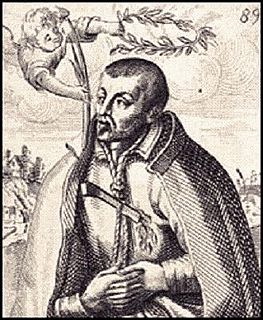
Robert Southwell, also Saint Robert Southwell, was an English Roman Catholic priest of the Jesuit Order. He was also a poet, hymnodist, and clandestine missionary in Elizabethan England.
Richard Topcliffe was a priest hunter and practitioner of torture during the reign of Elizabeth I of England. A landowner and Member of Parliament, he became notorious as the government's chief enforcer of the penal laws against the practice of Catholicism.

John Ogilvie was a Scottish Jesuit martyr. For his work as a priest in service to a persecuted Roman Catholic community in 17th century Scotland, and in being hanged for his faith, he became the only post-Reformation Scottish saint.

Edmund Arrowsmith, SJ was one of the Forty Martyrs of England and Wales of the Catholic Church. The main source of information on Arrowsmith is a contemporary account written by an eyewitness and published a short time after his death. This document, conforming to the ancient style of the "Acts of martyrs" includes the story of the execution of another 17th-century recusant martyr, Richard Herst.
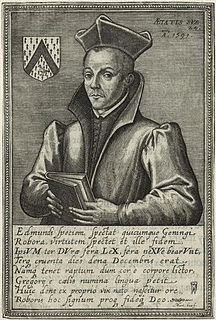
Edmund Gennings was an English martyr, who was executed during the English Reformation for being a Catholic priest. He came from Lichfield, Staffordshire. His name is sometimes spelled Jennings.

John Boste is a saint in the Catholic Church, and one of the Forty Martyrs of England and Wales.

John Jones, also known as John Buckley, John Griffith, Godfrey Maurice, or Griffith Jones was a Franciscan friar, Roman Catholic priest, and martyr. He was born at Clynnog Fawr, Caernarfonshire (Gwynedd), Wales, and was executed 12 July 1598 at Southwark, England. He is one of the Forty Martyrs of England and Wales.
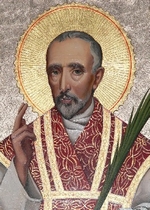
John Southworth was an English Catholic martyr. He is one of the Forty Martyrs of England and Wales.

John Ingram was an English Jesuit and martyr from Stoke Edith, Herefordshire, who was executed in Gateshead on 26 July 1594, during the reign of Elizabeth I.
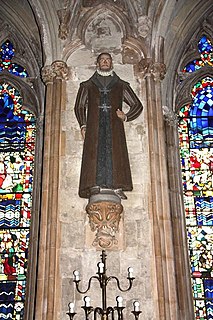
Swithun Wells was an English Roman Catholic martyr who was executed during the reign of Elizabeth I. Wells was a country gentleman and one time schoolmaster whose family sheltered hunted priests. He himself often arranged passage from one safehouse to another. His home in Gray's Inn Lane was known to welcome recusants.
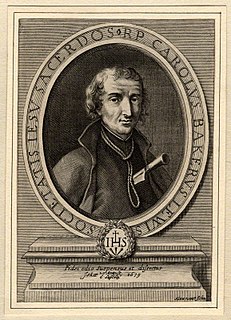
David Lewis, S.J. was a Jesuit Catholic priest and martyr who was also known as Charles Baker. Lewis was canonized by Pope Paul VI in 1970 as one of the Forty Martyrs of England and Wales and is venerated as a saint in the Catholic Church. His feast day is celebrated on 27 August.
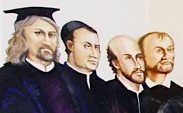
Polydore Plasden (1563–1591) was one of the Catholic Forty Martyrs of England and Wales. A native of London, he studied for the priesthood at Rheims and Rome and was ordained in 1586 before being sent back to England soon after.
Christopher Bales, also spelled Christopher Bayles, alias Christopher Evers (c.1564–1590), was an English Catholic priest and martyr. He was beatified in 1929.
Edward Waterson was an English Catholic priest and martyr. He served the hidden Catholics in England during the reign of Elizabeth I. Edward was arrested in 1593 and executed at Newcastle upon Tyne. He was beatified in 1929.
Thomas Pormort was an English Roman Catholic priest. He was beatified in 1987.
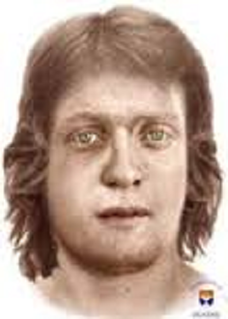
Peter Snow was an English Roman Catholic priest. He is a Catholic martyr, along with Ralph Grimston who died with him, beatified in 1987. Their liturgical celebration is on 15 June.
Anthony Middleton was an English Roman Catholic priest and martyr from Yorkshire. He trained at Douai College, and returned to England in 1586. He was captured by Richard Topcliffe in Fleet Street, London, close to where he was hanged, drawn and quartered with Edward Jones on 6 May 1590.

The Oaten Hill Martyrs were Catholic Martyrs who were executed by hanging, drawing and quartering at Oaten Hill, Canterbury, on 1 October 1588. The gallows had been put up in 1576. These four were beatified by Pope Pius XI in 1929.
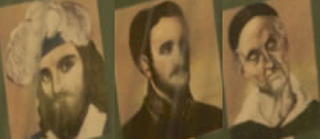
John Carey was martyred at Dorchester, Dorset, England for adherence to the Roman Catholic faith. His feast day is 4 July.














